Research on Urban Energy Sustainable Plan under the Background of Low-Carbon Development
Abstract
:1. Introduction
2. Materials and Methods
2.1. Data Source
2.1.1. Natural Resources of Sino-Singapore Tianjin Eco-City
- 1.
- Solar energy resources
- 2.
- Geothermal resources
- 3.
- Biomass resources
2.1.2. Energy Consumption of Sino-Singapore Tianjin Eco-City in 2020
2.1.3. Research Objective
2.2. Calculation Method of Urban Carbon Emission
2.2.1. Computational Boundary
2.2.2. Carbon Emission Calculation Model
- 4.
- Calculation of building carbon emissions
- 5.
- Calculation of transportation carbon emissions
- 6.
- Calculation of industrial carbon emissions
- 7.
- Calculation of carbon sink
2.2.3. Emission Factor
2.3. Prediction Methods of Urban Energy Consumption and Carbon Emissions
2.3.1. Baseline Scenario
2.3.2. Low-Carbon Scenario
2.3.3. Enhanced Low-Carbon Scenario
2.4. Calculation of Renewable Energy Utilization Rate
3. Results
3.1. Carbon Emission Status and Scenario Analysis of Sino-Singapore Tianjin Eco-City
3.1.1. Carbon Emission Status in 2020
3.1.2. Carbon Emission Prediction for Baseline Scenario
3.1.3. Carbon Emission Prediction for Low-Carbon Scenario
3.2. Renewable Energy Planning for Sino-Singapore Tianjin Eco-City
3.2.1. Renewable Energy Planning Program
- 1.
- Energy-Efficient buildings
- 2.
- Renewable energy utilization in buildings
- 3.
- Renewable energy for heating
- 4.
- Terminal energy-using electrification
- 5.
- Large and medium-sized municipal renewable energy sources
3.2.2. Planning Indicators for Renewable Energy
3.2.3. Calculation of Carbon Sink
3.2.4. Carbon Emission Prediction for Enhanced Low-Carbon Scenario
3.3. Evaluation of Renewable Energy Planning
4. Discussion
4.1. Demand-Oriented Renewable Energy Planning
4.2. Promote the Development and Utilization of Solar Energy Resources
4.3. Develop Renewable Energy for Heating
4.4. Innovative Development of Other Renewable Energy Sources
5. Conclusions
5.1. Contribution and Significance
5.2. Deficiency and Prospect
Author Contributions
Funding
Institutional Review Board Statement
Informed Consent Statement
Data Availability Statement
Acknowledgments
Conflicts of Interest
References
- Perkins, J.H. The Dilemmas of Energy: Essential energy services and potentially fatal risks. IOP Conf. Ser. Earth Environ. Sci. 2018, 107, 012087. [Google Scholar] [CrossRef]
- Lee, J.; Park, J.; Jung, H.-J.; Park, J. Renewable Energy Potential by the Application of a Building Integrated Photovoltaic and Wind Turbine System in Global Urban Areas. Energies 2017, 10, 2158. [Google Scholar] [CrossRef]
- Hernandez-Escobedo, Q. Wind Energy Assessment for Small Urban Communities in the Baja California Peninsula, Mexico. Energies 2016, 9, 805. [Google Scholar] [CrossRef]
- Perea-Moreno, A.-J.; García-Cruz, A.; Novas, N.; Manzano-Agugliaro, F. Rooftop analysis for solar flat plate collector assessment to achieving sustainability energy. J. Clean. Prod. 2017, 148, 545–554. [Google Scholar] [CrossRef]
- National Bureau of Statistics of China. China Statistical Yearbook; China Statistical Publishing House: Beijing, China, 2022. (In Chinese)
- Perea-Moreno, A.-J.; Aguilera-Ureña, M.-J.; Manzano-Agugliaro, F. Fuel properties of avocado stone. Fuel 2016, 186, 358–364. [Google Scholar] [CrossRef]
- Icaza, D.; Borge-Diez, D.; Galindo, S.P. Proposal of 100% renewable energy production for the City of Cuenca—Ecuador by 2050. Renew. Energy 2021, 170, 1324–1341. [Google Scholar] [CrossRef]
- Deakin, M.; Reid, A. Smart cities: Under-gridding the sustainability of city-districts as energy efficient-low carbon zones. J. Clean. Prod. 2018, 173, 39–48. [Google Scholar] [CrossRef]
- Timilsina, G.R.; Shrestha, A. Transport sector CO2 emissions growth in Asia: Underlying factors and policy options. Energy Policy 2009, 37, 4523–4539. [Google Scholar] [CrossRef]
- Zhang, J.; Xie, Y.; Luan, B.; Chen, X. Urban macro-level impact factors on Direct CO2 Emissions of urban residents in China. Energy Build. 2015, 107, 131–143. [Google Scholar] [CrossRef]
- Wang, H.; Zeng, W. Revealing urban carbon dioxide (CO2) emission characteristics and influencing mechanisms from the perspective of commuting. Sustainability 2019, 11, 385. [Google Scholar] [CrossRef]
- Yu, J.; Da, Y.; Ou, Y. Spatio-temporal difference of transportation greenhouse gas emissions and its influencing factors in China. China J. Highw. Transp. 2015, 28, 112–119. [Google Scholar]
- Posso, F.; Espinoza, J.L.; Sánchez, J.; Zalamea, J. Hydrogen from hydropower in Ecuador: Use and impacts in the transport sector. Int. J. Hydrogen Energy 2015, 40, 15432–15447. [Google Scholar] [CrossRef]
- Karin, R. Hannover Kronsberg Handbook; Stadt Hannover: Hannover, Germany, 2001. [Google Scholar]
- Feng, H.; Wang, R.; Zhang, H. Research on Carbon Emission Characteristics of Rural Buildings Based on LMDI-LEAP Model. Energies 2022, 15, 9269. [Google Scholar] [CrossRef]
- Fang, G.; Wang, C.; Zhang, S. Cluster analysis of greenhouse gas emissions peaking trends in Chinese cities. China Envion. Manag. 2021, 13, 40–48. [Google Scholar]
- Dong, Y.; Zhong, H.; Lu, Z.; Xu, B.; Zou, S. Cluster analysis of prefecture-level cities in Gansu Province for low carbon transformation. J. Desert. Res. 2020, 40, 25–31. [Google Scholar]
- Bin, Z.; Yao, N.; Liu, X. Preliminary fuzzy clustering analysis on greenhouse gas emissions in Different Province of China. China Popul. Resour. Environ. 2011, 21, 53–56. [Google Scholar]
- Saldivar-Sali, A.N.D. A Global Typology of Cities: Classification Tree Analysis of Urban Resource Consumption; Massachusetts Institute of Technology: Cambridge, MA, USA, 2010. [Google Scholar]
- Hu, Y.; Peng, L.; Li, X.; Yao, X.; Lin, H.; Chi, T. A novel evolution tree for analyzing the global energy consumption structure. Energy 2018, 147, 1177–1187. [Google Scholar] [CrossRef]
- Creutzig, F.; Baiocchi, G.; Bierkandt, R.; Pichler, P.-P.; Seto, K.C. Global typology of urban energy use and potentials for an urbanization mitigation wedge. Proc. Natl. Acad. Sci. USA 2015, 112, 6283–6288. [Google Scholar] [CrossRef]
- GB/T 51255-2017; Ministry of Housing and Urban-Rural Development of the People’s Republic of China. Assessment Standard for Green Eco-District. China Architecture & Building Press: Beijing, China, 2018. (In Chinese)
- Elliston, B.; MacGill, I.; Diesendorf, M. Comparing least cost scenarios for 100% renewable electricity with low emission fossil fuel scenarios in the Australian National Electricity Market. Renew. Energy 2014, 66, 196–204. [Google Scholar] [CrossRef]
- Glasnovic, Z.; Margeta, J. Vision of total renewable electricity scenario. Renew. Sustain. Energy Rev. 2011, 15, 1873–1884. [Google Scholar] [CrossRef]
- Spiecker, S.; Weber, C. The future of the European electricity system and the impact of fluctuating renewable energy e a scenario analysis. Energy Pol. 2014, 65, 185–197. [Google Scholar] [CrossRef]
- Mathiesen, B.V.; Lund, H.; Connolly, D.; Wenzel, H.; Østergaard, P.A.; Möller, B.; Nielsen, S.; Ridjan, I.; Karnøe, P.; Sperling, K.; et al. Smart Energy Systems for coherent 100% renewable energy and transport solutions. Appl. Energy 2015, 145, 139–154. [Google Scholar] [CrossRef]
- Calle, P.A.; Fajardo, N.M.A.; Reinoso, A.C.A. Polucion Atmosferica por Automotores y Enfermedad Respiratoria. Bachelor’s Thesis, Universidad de Cuenca, Cuenca, Ecuador, 1998. [Google Scholar]
- Borja, M.O.; Aragon-Osejo, J.; Josse, C. EJE 02-04 Contaminacion por ruido en centros urbanos. Mem. Univ. Azuay 2017, XVI, 77–80. [Google Scholar]
- Sun, X.; Song, K. Exploration and Practice of Green Building Management in Sino-Singapore Tianjin Eco-City. China City Plan. Rev. 2016, 25, 50–57. [Google Scholar]
- Tianjin Municipal Burcau of Statistics & Survey Office of the National Bureau of Statistics in Tianjin. Tianjin Statistical Yearbook; China Statistical Publishing House: Beijing, China, 2022. (In Chinese)
- He, K.; Huo, H.; Zhang, Q.; He, D.; An, F.; Wang, M.; Walsh, M.P. Oil consumption and CO2 emissions in China’s road transport: Current status, future trendsand policy implications. Energy Policy 2005, 33, 1499–1507. [Google Scholar] [CrossRef]
- Huo, H.; Zhang, Q.; Wang, M.Q.; Streets, D.G.; He, K. Environmental Implication of Electric Vehicles in China. Environ. Sci. Technol. 2010, 44, 4856–4861. [Google Scholar] [CrossRef]
- Li, L.; Chen, C.; Xie, S.; Huang, C.; Cheng, Z.; Wang, H.; Wang, Y.; Huang, H.; Lu, J.; Dhakal, S. Energy demand and carbon emissions under different development scenarios for Shanghai, China. Energy Policy 2010, 38, 4797–4807. [Google Scholar] [CrossRef]
- IPCC. Revised 1996 IPCC Guidelines for National Greenhouse Gas Inventories. In Intergovernmental Panel on Climate Change; IPCC: London, UK, 1996. [Google Scholar]
- Bao, L.; Zhang, H. Study on influencing factors of construction industry carbon emissions in Jiangsu Province based on LMDI model. Environ. Sci. Technol. 2021, 44, 202–212. [Google Scholar]
- Department of Energy Statistics. National Bureau of Statistics. China Energy Statistical Yearbook 2020; China Statistics Press: Beijing, China, 2021. (In Chinese)
- Niu, L.; Pan, M.; Zhou, Y. Evaluation method for urban renewable energy tilization efficiency based on DEA model. Int. J. Glob. Energy Issues 2020, 42, 127–143. [Google Scholar] [CrossRef]
- Tianjin Municipal Bureau of Planning and Natural Resources. Tianjin Land Resources and Housing Administration on the Answer to the 5th Session of the 13th CPPCC Proposal No. 0173. Available online: https://ghhzrzy.tj.gov.cn/zwgk_143/jyta/zxtabljggk/202012/t20201205_4485057.html (accessed on 14 November 2017).
- The People’s Government of Tianjin Binhai New Area. Notice on Expanding the Scope of Pilot Implementation of the “Tianjin Binhai New Area Green Building and Passive Building Incentive Measures (Trial)”. Available online: https://zjw.tjbh.gov.cn/contents/9782/269564.html (accessed on 21 December 2021).
- Gutiérrez, R.; Marlene, E.; Iddar, I.P.; Jarrin, M.E. Política económica de la Unión Europea en la disminución del consumo de hidrocarburos desde el 2020. Rev. Univ. Soc. 2019, 11, 15–30. [Google Scholar]
- Wang, M.; Li, T.; Yuan, C.; Tian, H.; Tian, S. Research on vehicle renewable energy use in cities with different carbon emission characteristics. Energy Rep. 2022, 8, 343–352. [Google Scholar] [CrossRef]
- Kellogg, W.D.; Nehrir, M.H. Generation unit sizing and cost analysis for stand-alone wind, photovoltaic, and hybrid wind/PV systems. IEEE Trans. Energy Convers 1998, 13, 70–75. [Google Scholar] [CrossRef]
- Curreli, A.; Serra-Coch, G.; Isalgue, A.; Crespo, I.; Coch, H. Solar Energy as a Form Giver for Future Cities. Energies 2016, 9, 544. [Google Scholar] [CrossRef]
- Miguel-Angel, P.; Quetzalcoatl, H.; Alberto-Jesus, P. Renewable Energy in Urban Areas: Worldwide Research Trends. Energies 2018, 11, 577. [Google Scholar]
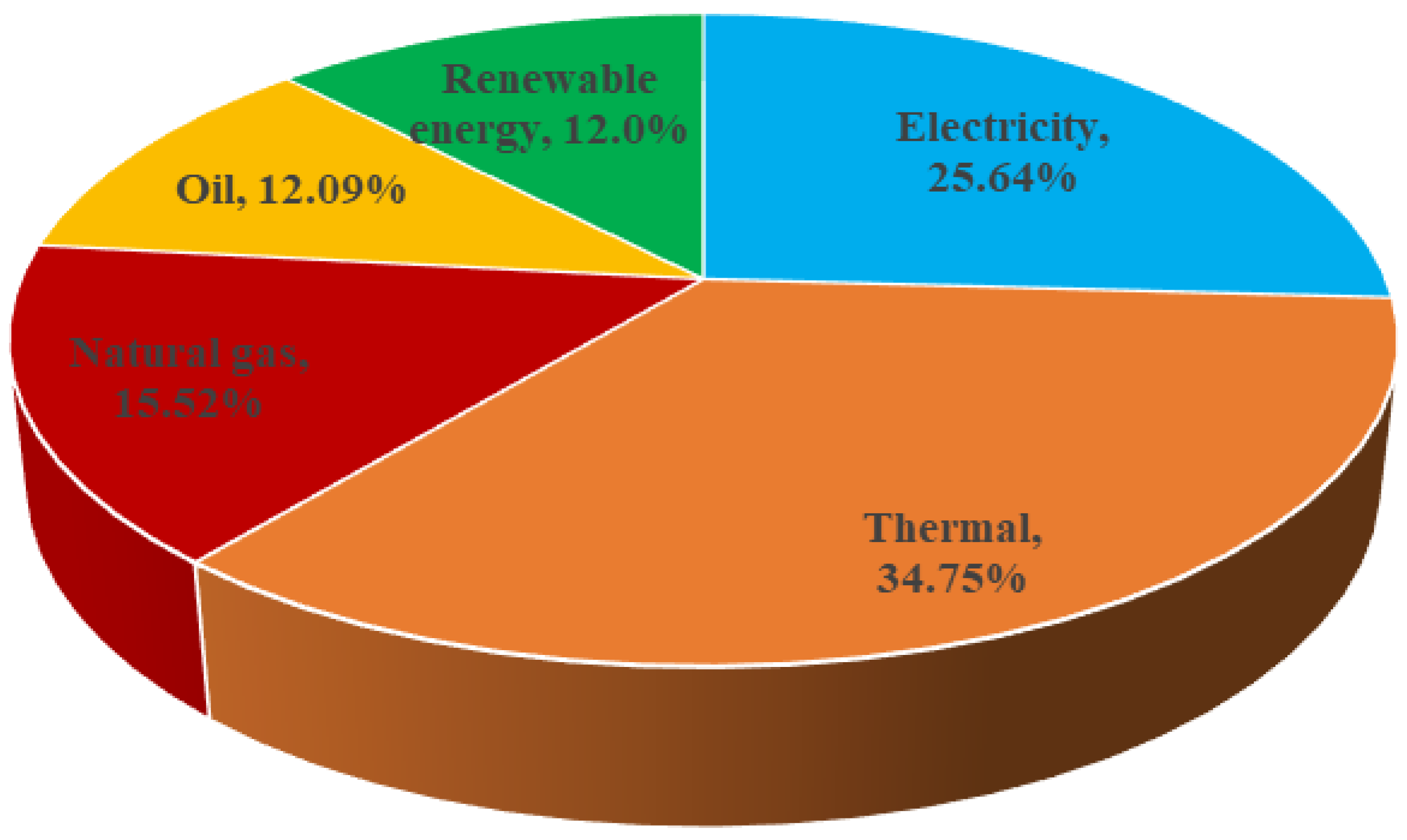
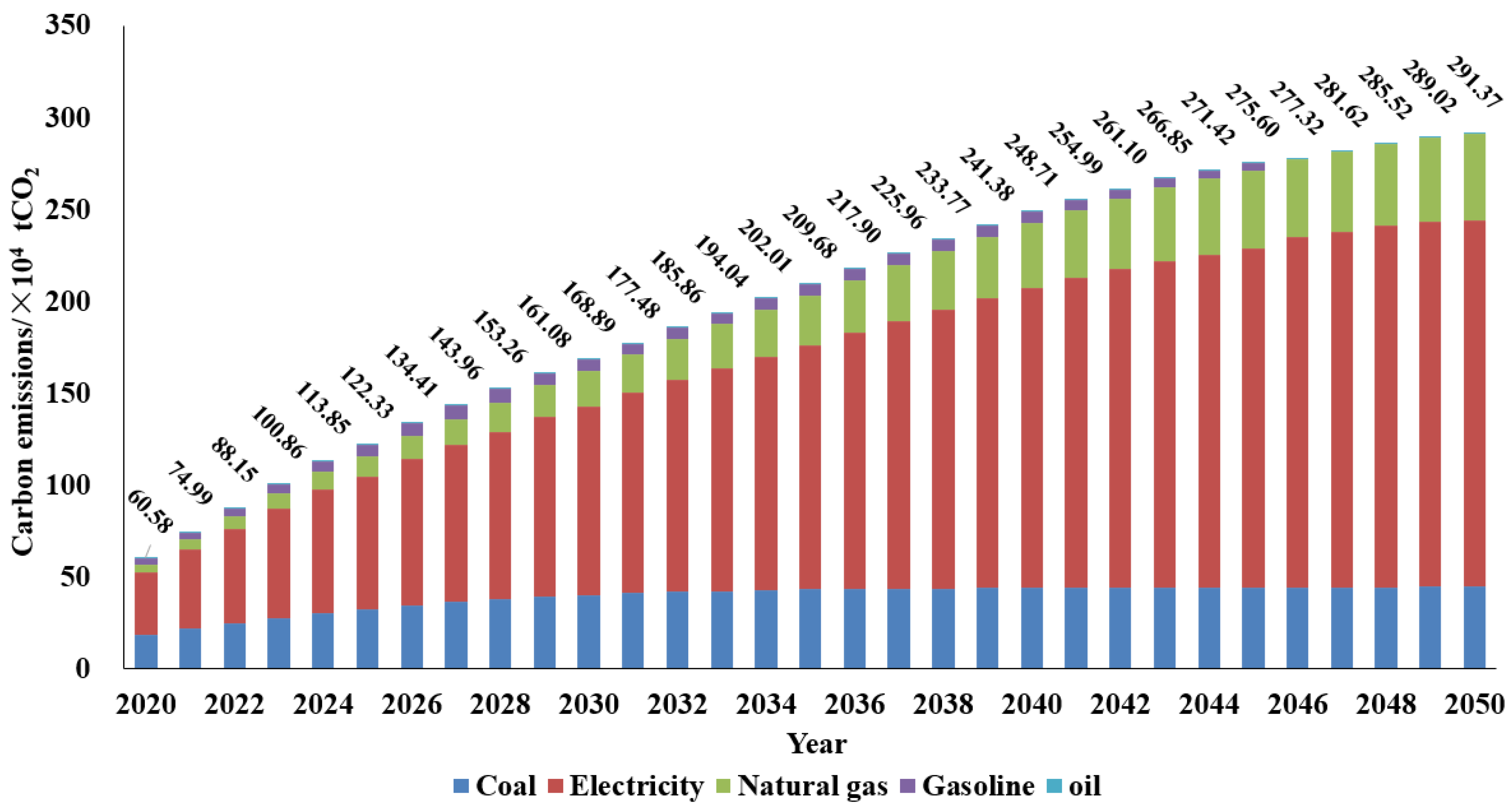
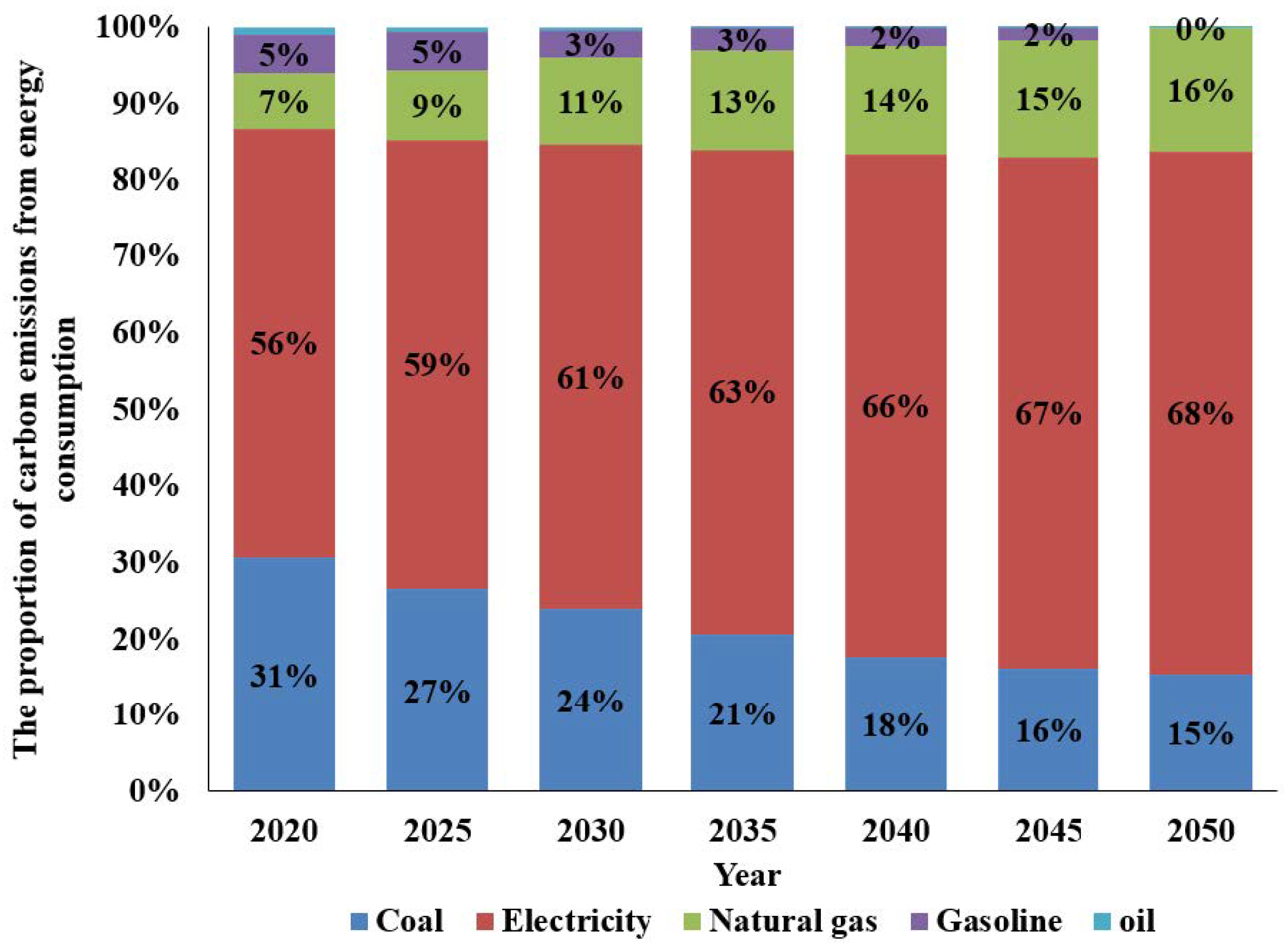


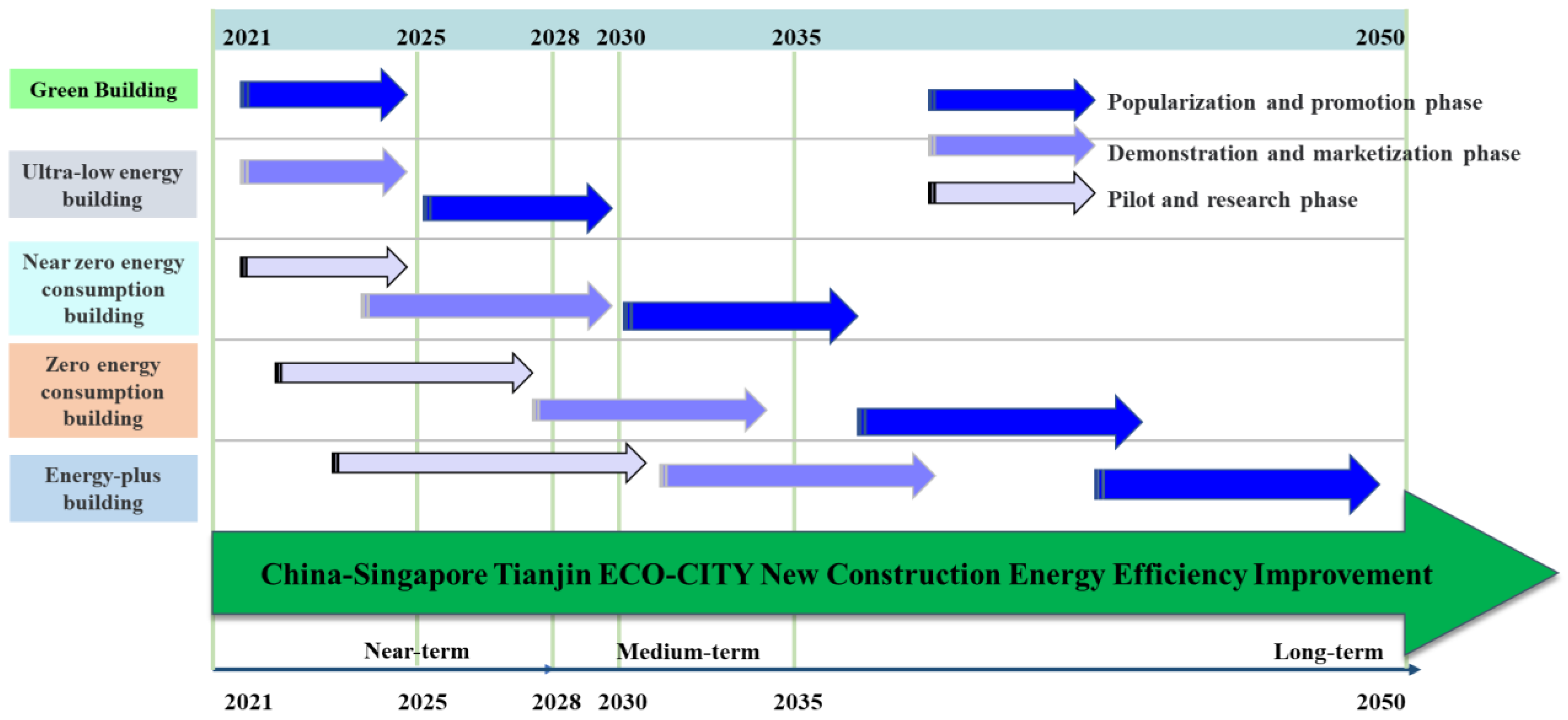

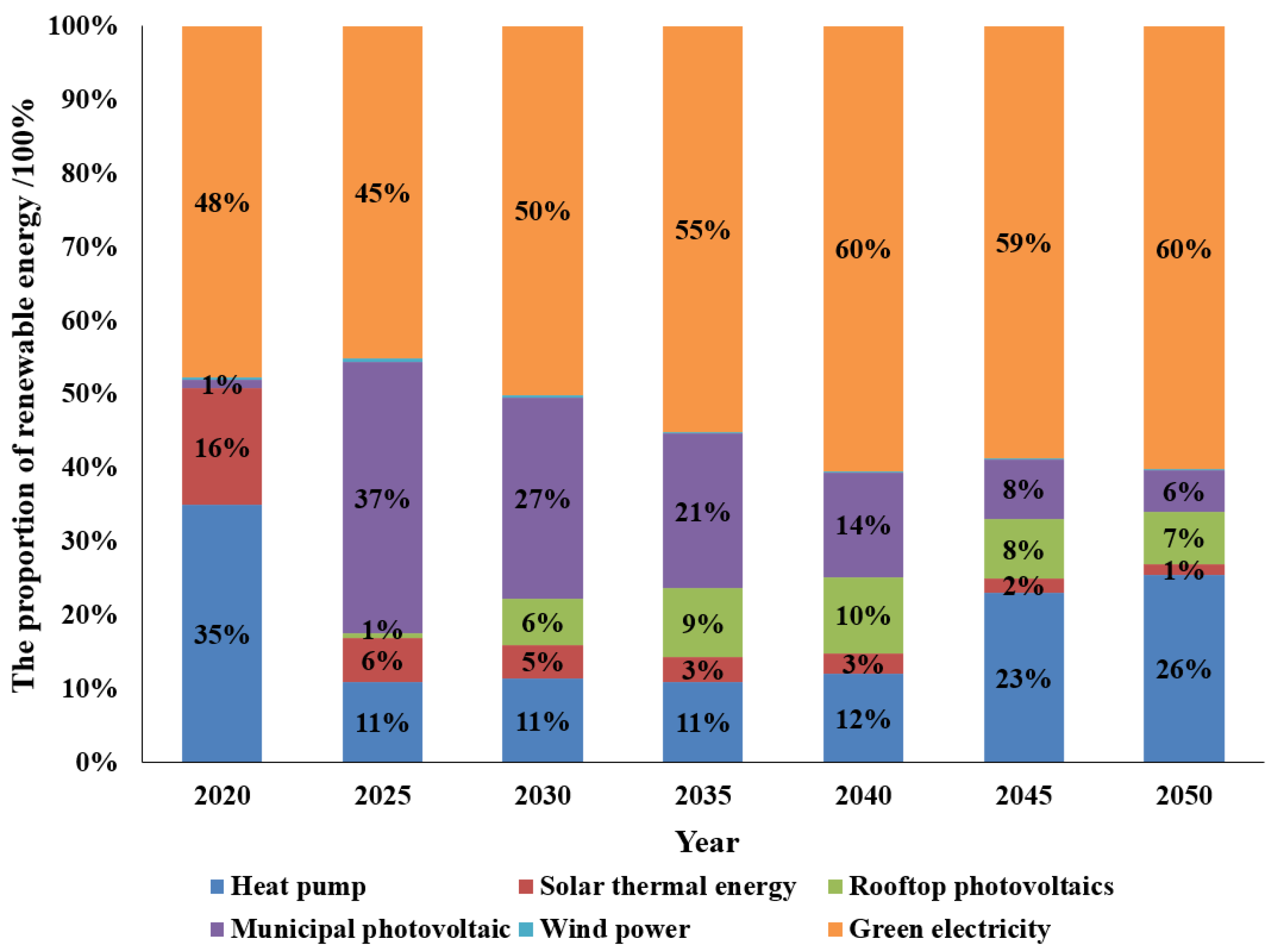
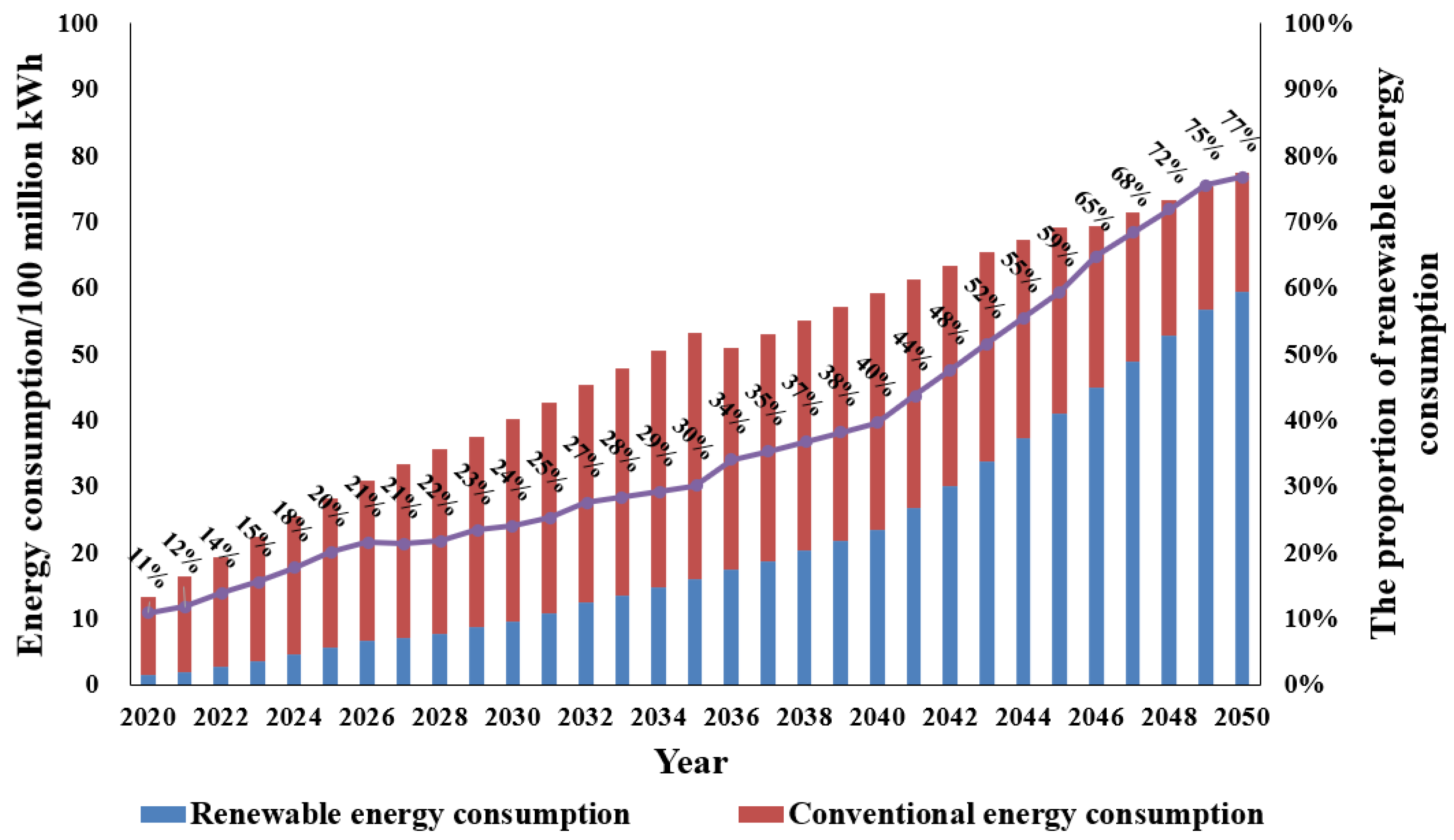
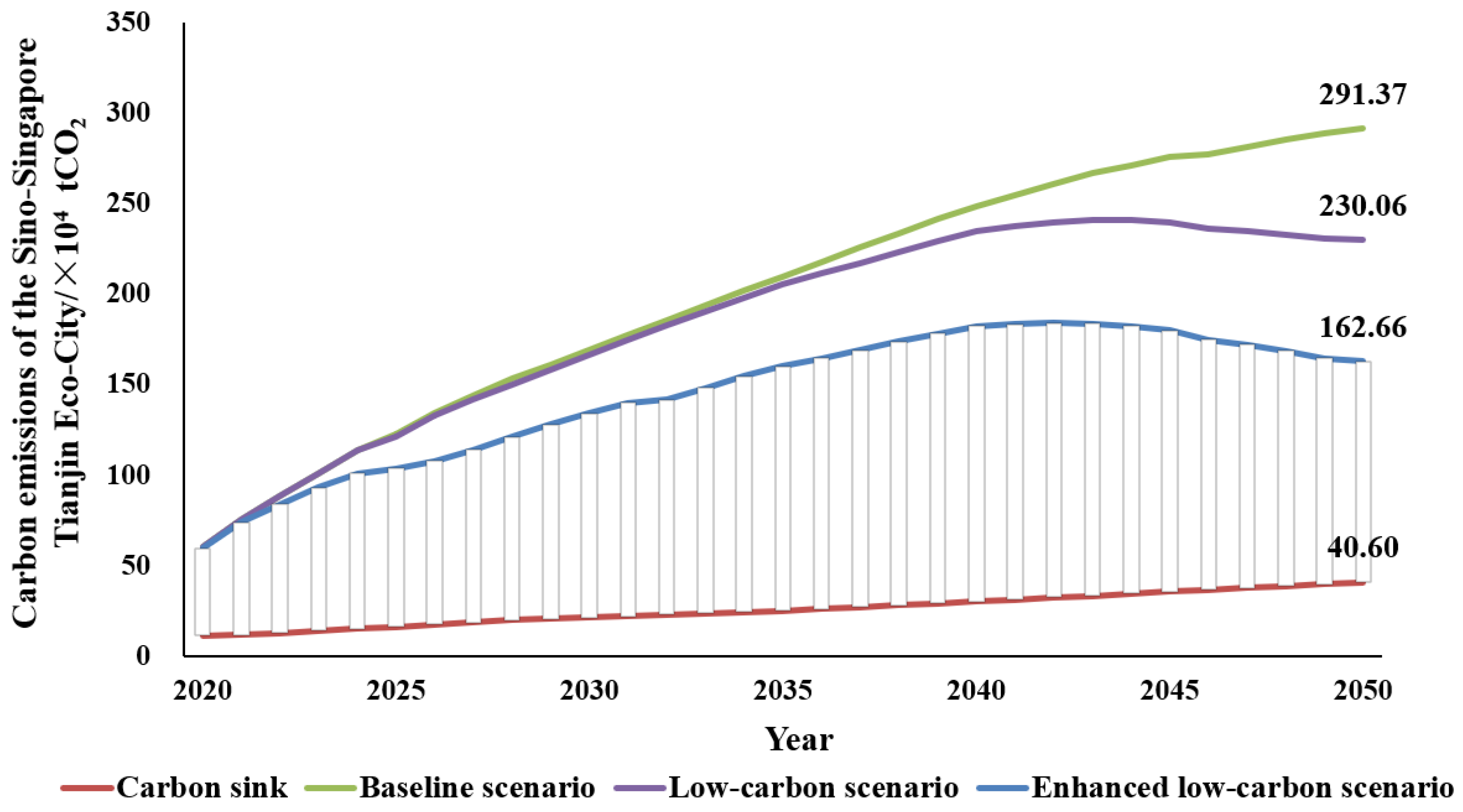
| Carbon Emission Source | Coal ×108 kWh/a | Power ×107 kWh/a | Gas ×105 Nm3/a | Oil ×106 L/a | |
|---|---|---|---|---|---|
| Building | Residence | 4.67 | 19.91 | 44.40 | / |
| Business | 10.45 | 18.51 | / | ||
| Office | 0.68 | 0.08 | / | ||
| Education | 0.87 | 1.66 | / | ||
| Public facilities | 0.84 | / | / | ||
| Hospital | 0.48 | / | / | ||
| Industry | M1 | 0.80 | 10.10 | / | / |
| M2 | 0.07 | 6.80 | / | / | |
| Traffic | Sanitation truck | / | 0.04 | 0.13 | / |
| Taxi | / | 0.44 | 14.60 | 2.56 | |
| Electric bicycle | / | 8.69 | / | / | |
| Car | / | 2.30 | / | 12.26 | |
| Bus | / | 0.33 | 10.91 | / | |
| Type of Energy | Emission Factor | Unit | Data Source |
|---|---|---|---|
| Electricity | 0.8733 | kgCO2/kWh | Average carbon emission factor of Tianjin power grid, which was consulted from local authorities. |
| gasoline | 2.9267 | tCO2/t | IPCC Guidelines for national greenhouse gas emission inventories [34]. |
| Diesel oil | 3.0938 | tCO2/t | IPCC Guidelines for national greenhouse gas emission inventories [34]. |
| Natural gas | 21.6072 | tCO2/104m3 | IPCC Guidelines for national greenhouse gas emission inventories [34]. |
| Heat | 3.96 × 10−4 | tCO2/kWh | China energy statistical yearbook 2021 [36]. |
| greenbelt | 2.71 | kg CO2/m2 | Average carbon sink factor per unit green area in North China [35]. |
| Type | 2021 | 2028 | 2035 | 2050 |
|---|---|---|---|---|
| Ratio of green space/% | 11.3 | 19.6 | 24.8 | 40.6 |
| Green area/km2 | 11.41 | 19.83 | 25.07 | 40.84 |
| Carbon sink/tCO2 | 11.3 | 19.6 | 24.8 | 40.6 |
| Type | Energy Consumption | Carbon Emission ×104 tCO2 | Greed Space km2 | Leading Technology | Investment Budget ×108 CNY | ||
|---|---|---|---|---|---|---|---|
| Traditional Energy | Renewable Energy | Total ×108 kWh/a | |||||
| Baseline scenario | 88% | 12% | 89.66 | 291.37 | 40.84 | 1. Solar thermal energy 2. Rooftop photovoltaics | 6.24 |
| Low-carbon scenario | 74% | 26% | 77.33 | 230.06 | 40.84 | 1.Heat pump 2. Solar thermal energy 3. Rooftop photovoltaics | 13.54 |
| Enhanced low-carbon scenario | 23% | 77% | 77.33 | 162.66 | 40.84 | 1.Heat pump 2. Solar thermal energy 3. Rooftop photovoltaics 4. Green electricity 5. Municipal photovoltaic 6. Wind power | 40.08 |
| Supply Side Energy Planning | Demand-Side Energy Planning | |
|---|---|---|
| Technical route | Consumption of high-temperature, high-pressure and high-grade energy. | Emphasize the step use of energy. Low-temperature, low-pressure and low-grade energy. |
| It is dominated by fossil energy. | Multi-source coupled system. | |
| Centralized system. | Energy networking. | |
| Meet the needs of the industrial era. | Meet the needs of the post-industrial era. | |
| Steady load. | Variable load. | |
| Centralized production capacity. | Distributed capacity. | |
| Remote transmission. | Nearby transportation. | |
| One-way supply. | Two-way supply. | |
| methodology | Load forecasting: focus on peak load forecasting under extreme energy use. | Load forecasting: focus on user energy reduction forecasting. |
| Use energy extensively, intensively and uniformly. | Use energy delicately, scatteringly, individualistically. | |
| Centralized operation. | Flexible operation. | |
| The system runs under low load for a long time. | The system runs under high load for a long time. | |
| Electricity is uniformly distributed by the grid. | Electricity is self-used, and excess electricity is incorporated into the grid or used for cooling and heating systems. |
Disclaimer/Publisher’s Note: The statements, opinions and data contained in all publications are solely those of the individual author(s) and contributor(s) and not of MDPI and/or the editor(s). MDPI and/or the editor(s) disclaim responsibility for any injury to people or property resulting from any ideas, methods, instructions or products referred to in the content. |
© 2023 by the authors. Licensee MDPI, Basel, Switzerland. This article is an open access article distributed under the terms and conditions of the Creative Commons Attribution (CC BY) license (https://creativecommons.org/licenses/by/4.0/).
Share and Cite
Wang, Q.; Sun, X.; Wang, R.; Zhou, L.; Zhou, H.; Di, Y.; Li, Y.; Zhang, Q. Research on Urban Energy Sustainable Plan under the Background of Low-Carbon Development. Sustainability 2023, 15, 14206. https://doi.org/10.3390/su151914206
Wang Q, Sun X, Wang R, Zhou L, Zhou H, Di Y, Li Y, Zhang Q. Research on Urban Energy Sustainable Plan under the Background of Low-Carbon Development. Sustainability. 2023; 15(19):14206. https://doi.org/10.3390/su151914206
Chicago/Turabian StyleWang, Qingqin, Xiaofeng Sun, Ruonan Wang, Lining Zhou, Haizhu Zhou, Yanqiang Di, Yanyi Li, and Qi Zhang. 2023. "Research on Urban Energy Sustainable Plan under the Background of Low-Carbon Development" Sustainability 15, no. 19: 14206. https://doi.org/10.3390/su151914206





